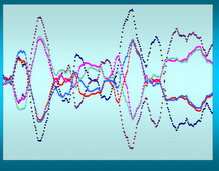Let's take a look at a 2-hour chart.

As you can see you can use the same technical analysis tools on the 2-hour charts that you use with any other time frame. The difference being you cross day boundaries when using 2-hour charts.
The prevalent formation on the 2-hour charts is the cross over but you will find a BOB every now and then. I've circled the two cross overs on this one and put a rectangle around the BOB.
Here's another 2-hour chart.

Again we find both the cross over and the BOB.
And one more - this one is HST and it contains a number of strange patterns -

But when we look at this on a color-coded chart such as the ones I use in QuoteTracker you can see that it is actually an RSI(2) < 2 and I use those to inform me when to add to my holdings or to day trade using my holdings.

The long purple bar is how I have the chart tell me about the RSI activity.
You can also see on this chart how the 2-hour charts support pivot points as well.
I currently own all of these stocks. That doesn't mean that I will own them later today or even five minutes from now - but right now I do own them.

2 comments:
Did you notice on the BGG chart that the volume on the fourth day was > than that of the BOB confirmation day? Maybe those setups would be good for a one or two day scalp?
I had to comment----my father was a 44 year employee of Briggs and Stratton. Talk about loyalty.
Enjoy your afternoon.
Philip
You make some good points regarding your volume requirements - higher volume normally means interest in the stock above and beyond the norm. Now - take this to the ultimate - is it every stock or only some stocks? What is the beta of the stocks where the volume is greater? And - what was the market doing when the stock went up? - If the market was down and reversed did that tend to raise the stock with it? Is the stock going up against the market (my favorite kind) and so on.
Always keep in mind - volume is probably the most important factor but the point of the BOB is to provide a starting point - a point of departure if you will
- it might work or it might not - it works better on some time frames than others but not perfectly on any.
That's why I say use the highest volume output by the filter as your best selection and go from there.
Post a Comment